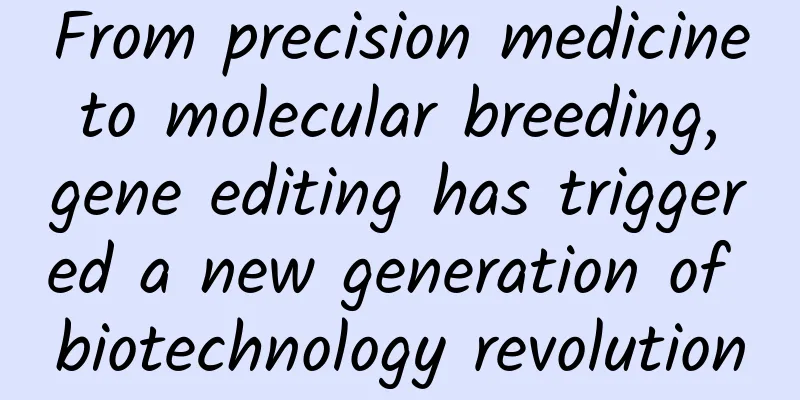From precision medicine to molecular breeding, gene editing has triggered a new generation of biotechnology revolution

|
Introduction In the past two years, gene editing technology has been very popular. It is not only an essential technology for every molecular laboratory, but also has generated a large number of applications, including molecular breeding, variety improvement, gene therapy and other aspects. Today we are interviewing Professor Gu Feng from the School of Medicine of Hunan Normal University and "Xiaoxiang Scholar" Distinguished Professor. Professor Gu will explain to us the application and future development of gene editing technology. Q: Can you introduce the application prospects of gene editing technology? Gu Feng: The current medical applications of gene editing technology generally include the following: First, animal models. In the early days, only rats and mice (mainly mice) were used as animal models. After the addition of gene editing technology, we can make most of the animals we want, such as rabbits, dogs, and pigs. For pigs, we can do disease-resistant breeding research. For example, after editing a certain gene, pigs will not be infected with a certain virus. This can be applied in agriculture, food, and animals. The world's first CRSPR/Cpf1 gene rabbit and pig model There is also molecular breeding in plants, such as soybeans and rice. Basically, any plant we can think of can be gene-edited. So gene editing technology is very important for breeding. High Oleic Soybean What is the most important application in medicine? Treatment, including the screening of drug targets. Taking the new coronavirus as an example, to know how the new coronavirus interacts with cells, we can knock out the genes in the cells to see which gene will prevent the coronavirus from infecting, cannot replicate after infection, or cannot be released after replication. As long as any step is affected, the toxicity of the virus will theoretically decrease. Another point is that we use tools to transport genes directly into specific cells to complete gene repair. Some of the more important diseases here include retinal diseases in the eye. The eye is an immune-immune organ, so CRISPR/Cas9 and other therapeutic tools injected into it are not easily recognized by the immune system. Just like the film in our camera, if the genes of specific cells are repaired, the film will theoretically be more useful, the photos taken will be clearer, and people will be able to see them. There are also liver diseases, such as hypercholesterolemia, which is a very large category of diseases. It is very harmful and may cause sudden death, because cardiovascular diseases are very harmful and have a large patient population. If we can knock out and repair the specific LDLR gene, it can play a role in treating hypercholesterolemia. Of course, we can do specific repairs for different cases of hypercholesterolemia. Another major category is the blood system, which is represented by thalassemia. At present, China has done very well in this field, and its application and transformation in the international arena are basically in the first echelon. These are the main diseases that are currently treated with gene editing in medicine. There is also tumor immunity, which uses CAR-T and gene editing to transport specific molecules into T cells and then achieve specific elimination of tumors. In comparison, it is very promising. In general, our goal is to apply the latest technology to major clinical diseases, ultimately solving the disease and meeting clinical needs. Q: Can you introduce the application of CRISPR/Cas gene editing technology in the treatment of monogenic diseases? Gu Feng: The most cutting-edge treatment for single-gene diseases is thalassemia (treatment). The thalassemia population is large and there is a lack of effective treatment methods. In addition to blood transfusion and iron removal, early treatment methods also include stem cell transplantation. However, stem cell transplantation involves matching, so these two methods are actually very limited. The treatment of single-gene rare diseases is not to directly repair beta-globin and HBB genes (genes that cause thalassemia), but to manipulate the regulatory sequence to simulate a disease called HPFH. The symptoms of this disease are very mild, and the promoter region of another gene can be manipulated to achieve non-expression of the beta globin gene and β-globin. Specifically, it is to induce another stage of globin, so that it can have a relieving effect. So for now, its therapeutic effect is quite good. Another benefit of this treatment is that it can correct any mutation in the disease. This is due to the previous discovery of how genes are regulated. This work of predecessors is very useful for our treatment work today. I think this idea is very instructive for the treatment of other genetic diseases. It is equivalent to one drug that can cover all genes with different mutations. Q: What is the current situation of gene therapy for multi-gene genetic diseases? Gu Feng: For polygenic genetic diseases, several genes play a role, but each gene may have a different contribution rate. Theoretically, polygenic therapy is feasible. However, the main problem at present is that it is often difficult to simulate the disease. For example, if there are four genes and we want to do simulation experiments in mice, then we have to turn all four genes into mutant genes at the same time, which is a very large workload. In addition, each gene has its own contribution. Whether the genes of humans and mice can be completely simulated and analogized is a scientific question. Therefore, there is not much work being done in multi-gene therapy, mainly because the work is difficult to carry out and the (treatment) cycle is relatively long. As a technology, we must first make breakthroughs in areas that are easier to break through, and then slowly expand from point to surface. In theory, multi-gene therapy is very similar to single-gene therapy, but multi-gene (therapy) may require higher technology research and development requirements. Q: Can you tell us about the breeding of animals and plants? Gu Feng: In animal breeding, for example, pigs may be infected with a virus called PERV. After infection, pigs will develop a disease called porcine endogenous retrovirus (PERV), which is particularly harmful. Some researchers knocked out the CD163 gene, a specific receptor, and found that pigs may never be infected with the virus again after knocking out this gene. In theory, this can achieve a good breeding effect and avoid causing infection to the entire farm animal. In the past few years, when African swine fever broke out, we did this specific (gene editing) to resist African swine fever. Even if the African swine fever virus spreads, pigs can still survive and are not affected. Applying gene editing technology to animal breeding can greatly reduce breeding costs. The same is true for plants. For example, salt-tolerant, heat-tolerant, cold-tolerant or plants with high growth traits, to increase plant yield and improve quality, all depends on technological progress. Applying technology to national needs will not only allow us to have enough to eat, but also to eat well. In terms of fish breeding, Academicians Liu Jun and Liu Shaojun from Hunan Normal University have done a great job. Academicians Liu Yun (left) and Liu Shaojun (right) Q: Can you tell us about the breeding of animals and plants? Gu Feng: In animal breeding, for example, pigs may be infected with a virus called PERV. After infection, pigs will develop a disease called porcine endogenous retrovirus (PERV), which is particularly harmful. Some researchers knocked out the CD163 gene, a specific receptor, and found that pigs may never be infected with the virus again after knocking out this gene. In theory, this can achieve a good breeding effect and avoid causing infection to the entire farm animal. In the past few years, when African swine fever broke out, we did this specific (gene editing) to resist African swine fever. Even if the African swine fever virus spreads, pigs can still survive and are not affected. Applying gene editing technology to animal breeding can greatly reduce breeding costs. The same is true for plants. For example, salt-tolerant, heat-tolerant, cold-tolerant or plants with high growth traits, to increase plant yield and improve quality, all depends on technological progress. Applying technology to national needs will not only allow us to have enough to eat, but also to eat well. In terms of fish breeding, Academicians Liu Jun and Liu Shaojun from Hunan Normal University have done a great job. Q: Can you explain the difference between gene-edited crops and genetically modified crops? Gu Feng: The earliest transgenic research focused on transgenic cotton. By transcribing the BT gene, insects could not eat the cotton leaves, and eventually insect-resistant cotton was produced. Insect-resistant cotton has a high yield and does not require pesticides. Among the early transgenic plants, insect-resistant cotton was the most successful. We can also transfer genes into rice using the same strategy. In this way, rice will carry some products encoded by foreign genes. Now we are making gene-edited products, which are substantially different from genetically modified products. Genetic modification requires the transfer of exogenous genes into plants or animals, and they will eventually remain in the genome. As the name suggests, this exogenous gene is called a transgenic. But as far as gene editing is concerned, if we use RNA and protein to act on (crops), we can finally sequence and figure out every base through sequencing. Ultimately, exogenous substances will not remain in the genome. They only play an editing role and will be degraded quickly. Like space breeding, we send rice on the Shenzhou spacecraft to "take a trip" into space. When the seeds come back, they have mutated. After the mutation, we can breed them and find that the seeds may taste better. This is very similar to gene editing. Gene editing only plays an editing role, and no exogenous substances enter the animals and plants. High-throughput sequencing ensures that every base is clear, so this is completely different from genetic modification. Genetic modification will leave residual substances inside animals and plants, but gene editing will not leave any residues. So whether it is animals, plants or microorganisms, disease-resistant breeding and breeding under extreme conditions are all achievable. Therefore, the general public may have some concerns about GMOs, but for gene editing technology, in theory, as long as we do a good job of corresponding publicity and relevant popular science, I think everyone can accept it. Q: Finally, can you tell us about the future prospects of gene editing technology? Gu Feng: Gene editing technology has been around for ten years. Early tools may have had some problems, but overall, gene editing tools are becoming more and more accurate, easier to use, and more efficient. Of course, this does not mean that our current tools are good enough. In fact, there are still some problems. The main thing to look at when looking at gene editing tools is what they are used for. For example, for human treatment research, we hope that the tools are completely accurate. This is like high jump. Before, we could jump two meters. Now we hope to jump two meters and one meter, or even two meters and two meters, and then go up. This is a process of continuous improvement. So I think there is still a demand for the research and development of gene editing tools. In particular, the demand for gene editing tools at the clinical level is very strong. Of course, different diseases have different requirements for tools. For example, tumors have limited treatment methods and the treatment effect is relatively general, so the threshold for tumor tools is slightly lower. As long as the treatment effect is better and the patient is more likely to accept it, it will be more beneficial and less risky for the patient. At present, in the field of tumors, the requirements are not very high. But for genetic diseases, we hope to be as precise as possible. At present, our technology can still do the first batch of (treatment) work for some fatal and particularly harmful diseases. This article is a work supported by Science Popularization China Starry Sky Project Team/Author: Deep Science Reviewer: Tao Ning, Associate Researcher, Institute of Biophysics, Chinese Academy of Sciences Produced by: China Association for Science and Technology Department of Science Popularization Producer: China Science and Technology Press Co., Ltd., Beijing Zhongke Xinghe Culture Media Co., Ltd. |
Recommend
How to improve APP’s next-day retention?
What is next-day retention? Next-day retention, o...
What are the functions of the Tea Mall Mini Program? How much does it cost to develop a Tea Price Mini Program?
The tea drinking culture has a long history in my ...
Hummingbird: "I have the same beak as your flower"
In nature, although the hummingbirds and flowers ...
What is so special about oysters that they have been praised by the most talented foodie in history?
Su Shi, a great writer and calligrapher in the No...
Buying the wrong "New Year's Eve flower" may be illegal! Pay attention to these two points when distinguishing →
The Spring Festival is approaching, and New Year ...
Ask yourself! 15 questions that IT technicians must think about
People in the industry call themselves programmer...
Do you take oseltamivir as a "magic flu drug" when you have a fever? You should understand this before taking it →
Speaking of Oseltamivir I believe everyone is fam...
The “refined” community operation routines of online education!
In the online education sector, course communitie...
What is Wancibaping? Is it reliable to dominate the screen with 10,000 words? How to rank up
Whether Wancibaping is reliable or not does not l...
There are three points that can easily lead to misleading when buying a mobile phone. If you understand them, you will be considered an expert and can save a lot of money.
Today, I will talk to you about 3 points that are...
Can sugar-free drinks help you lose weight? Drink like this, or you'll gain weight!
Author: Tian Dawei Reviewer: Zhang Na, Associate ...
1080P becomes the golden resolution for mobile phones and is supported by half of foreign users
Nowadays, 4K screens are no longer exclusive to l...
"When will the bright moon appear?" is not just a poem! It actually contains so many scientific mysteries.
"When will the bright moon appear? I raise m...
The article layout is not good? Here are 4 design principles that are essential for operations
In "A Design Book for Everyone", Robin ...
To control fatty liver, should we eat less staple food or less meat?
A friend told me that he was only in his early fo...









